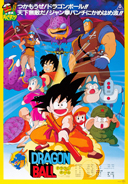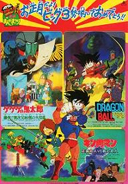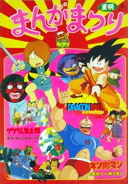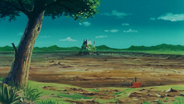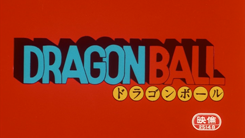
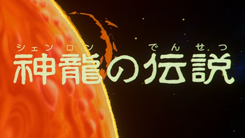
ドラゴンボール ・ 神龍の伝説
Doragon Bōru · Shenron no Densetsu
Dragon Ball – The Legend of Shenlong
General Information
| Premiered: | 20 December 1986 (“Toei Cartoon Festival”) |
| EIRIN Code: | 25148 |
| Running Time: | Approx. 50 minutes |
| Box Office: | Total Gross: Unknown Net Earnings: ¥800 million (approx. US $5 million) Attendance: 2.4 million |
| Opening Animation: | “Mystical Adventure!” (Dragon Ball Movie 1 Animation) |
| Ending Animation: | “I’ll Give You Romance” (Dragon Ball Movie 1 Animation) |
|
|
|
| Availability: |
VHS (09 May 1987 – Original Print / 21 July 1996 – Re-issue) Betamax and 8mm Film (09 May 1987) Dragon Box The Movies; Disc #01 (14 April 2006) Dragon Ball The Movies Individual DVD Volume #15 (13 March 2009) Dragon Ball The Movies Blu-ray Volume #08 (09 January 2019) |
Movie Premiere & Promotion
The movie premiered as part of the Winter 1986 “Toei Cartoon Festival” (東映まんがまつり; Tōei Manga Matsuri) on 20 December 1986, along with two other movies from the GeGeGe no Kitarō and Kinnikuman series. The “Toei Cartoon Festival” was established by Toei in 1969 as a way to showcase their popular children’s series as theatrical films during seasonal breaks in the school year: spring vacation, summer vacation, and winter vacation. In Japan, almost all schools below the university level run a three-term school year (trimester system) with a vacation period of several weeks to a month at the end of each trimester. The movies were screened together back-to-back in various cities across Japan, with a typical total running time of roughly three hours. Most festivals would last roughly one month, or as long as the seasonal vacation allowed. Tickets could be purchased at the theater, or discount tickets could be purchased in advance which covered the cost of admission, as well as a bonus item such as a promotional pamphlet describing the featured movies, and various other special presents, such as posters, paper hats, cards, and toys. Additional items, including the official theatrical pamphlet and a variety of other commemorative goods, were available for purchase at cinemas or by mail during this period.
Home Video Release
Up until the Dragon Box DVD sets began being released in the early 2000s, the only Dragon Ball properties released to home video in Japan were the original seventeen theatrical films, most of which were available on VHS, LaserDisc, and 8mm film reels. These home video releases were a luxury for most fans, as they came at a rather high price point for the time. They were later re-released in 1996 to replace the then out-of-print VHS tapes with a lower price point and slightly different covers.
After releasing the entirety of the three Dragon Ball TV series, Toei released their fifth and final “Dragon Box”, which was entitled “Dragon Box The Movies”. The Dragon Box contained all seventeen original Dragon Ball movies presented in their theatrical 16:9 widescreen aspect ratio. As a special bonus for the movie’s first DVD release, Toei dug through their vaults and included some of the movie’s original promotional material.
| News Flash (特報) Running Time: 30 seconds |
 |
| Digest (ダイジェスト) Running Time: 6 minutes, 25 seconds |
|
Following the “Dragon Box”, Toei began releasing each movie individually on DVD. To help promote the sale of movie individual discs, Shueisha handed out a free promotional DVD highlighting the releases at Jump Festa 2009. The DVD contained promotional trailers for each movie which were narrated by veteran Dragon Ball cast member Shigeru Chiba, the voice of such notable characters as Pilaf, Garlic Jr. (TV series), and Raditz. More information about the promotional DVD is available in our “Home Video Guide”.
In July 2018, the original seventeen theatrical films were released on Japanese Netflix and Amazon Prime streaming services. The addition of the movies themselves was heavily promoted throughout social media, however it was not announced or promoted at the time that they were actually new, high-definition remasters of the films scanned, and subsequently remastered, from the original film negatives. Shortly thereafter on 09 August 2018, Toei Animation formally announced the release of these newly-remastered versions of the movies across eight Blu-ray volumes. All non-credit versions of the opening and endings included with the release are up-converts of those originally included on the original LaserDisc releases and all bonus promotional materials (trailers, digests, etc.) are presented in their original standard definition format as included in the Dragon Box release.
Movie Synopsis
The great King Gurumes is searching for the Dragon Balls in order to put a stop to his endless hunger. While his two minions are claiming to be loyal in their search for the Dragon Balls, they are actually using much of the power of Gurumes’ army to purge the land of precious “Rich Stones” for their own personal wealth. A young girl named Pansy, who lives in the village surrounding Gurumes’ castle, has had enough of the treachery and decides to seek Muten Rōshi for assistance.
Elsewhere, a young boy named Goku runs into a girl in search of the Dragon Balls. The girl, Bulma, explains that his grandfather’s keepsake is really the Four-Star Ball. The two head back to his home on Mount Pao-tzu, only to discover that the Four-Star Ball has been stolen by Vongo and Pasta. Goku and Bulma pursue them in a capsule plane, but are shot down. The two start heading back, but run into Pansy, who is being attacked by a red oni. The oni transforms into a robot, but freaks out when Goku knocks down a tree with a single punch. The robot transforms and flees, but Goku soon catches him, discovering his true identity is the pig Oolong.
The desert bandit Yamcha suddenly appears and demands they hand over any money or capsules. Realizing how strong Goku is, Oolong has him fight Yamcha. The two clash, but Goku’s hunger soon sets in, and he is hit by Yamcha’s Rōga Fū-Fū Ken. Bulma appears on the scene, and Yamcha flees, as he’s weak against women. Later, Yamcha overhears Pansy mention that Gurumes’ target is the Dragon Balls, and he vows to obtain the Dragon Balls for himself in order to overcome his weakness against women.
Our heroes head to Kame House. There, Kame-Sen’nin uses the Kinto-Un to test Goku’s purity and is surprised to find that he is able to ride the cloud. Using Oolong’s transformation abilities, Bulma obtains the Three-Star Ball, but it is soon stolen by Vongo. He further aims for the Two-Star Ball, but Kame-Sen’nin repels the army with his special attack, the Kamehameha. Following by example, Goku fires a Kamehameha, and everyone is shocked. Pansy asks Kame-Sen’nin for his help, but he refuses, and our heroes depart without him to Gurumes’ castle.
Goku faces off against Vongo in an aerial battle, while Yamcha and the others infiltrate the castle. Yamcha fights back against the soldiers’ onslaught, but is defeated when he realizes that his opponent is Pasta, a female. As the battle enters Gurumes’ quarters, hunger overtakes the monarch, and he turns into a giant. Bulma realizes that the Dragon Balls are inside his stomach, so she throws the Two-Star Ball into his mouth and calls forth Shenlong. Pansy yells for “the country to be restored to the way it was”, and her wish is granted. Having returned to human size, Gurumes is surprised at how tasty an ordinary apple is. Goku then sets out on a journey to find the Four-Star Ball again.
Movie Characters & Items
The following original character profiles were translated from Daizenshuu 6, with additional character design comments from the movie’s character designer, Minoru Maeda, as published in the “Design Lab” section of the “Dragon Box The Movies” Dragon Book.
-
King Gurumes (グルメス王; gurumesu-ō)
The king of the Gurumes Kingdom. After the discovery of the Rich Stones, he became a monster only able to eat luxurious food. He plots to use the Dragon Balls to obtain the greatest delicacies in the world.I gave him this form based on the idea of gluttony. I think there was probably some influence from the gourmet boom at the time. The reptilian texture of his skin and such, I worked in consciously as “something Toriyama-sensei would be likely to draw”.
— Minoru Maeda -
Pasta (パスタ; pasuta)
A female warrior in the Gurumes Kingdom’s army. She used the king to obtain the Rich Stones, telling him she was really searching for the Dragon Balls. -
Vongo (ボンゴ; bongo)
Like Pasta, he is warrior in the Gurumes Kindgom’s army. He is a superhumanly strong man who uses his soldiers to dig up the Rich Stones. -
Pansy (パンジ; panji)
Wanting peace, she’s a girl with a pure heart. She lives with her parents, who are suffering under the misrule of the Gurumes Kindgom. She sets out alone on a trip to ask Muten Rōshi for help.
Items
- Various Mecha
These mecha items include submarines, robots, flying machines, etc. that appear in the movie.
During this time, I did the mecha designs along with the characters. I got a grasp of the nuances of Toriyama mecha by using not only Dragon Ball, but also the mecha and inventions that appear in Dr. Slump — Arale-chan, as a reference.
— Minoru Maeda -
Rich Stones (リッチストーン; ritchi sutōn)
The Rich Stones are the most valuable jewels in the world, discovered in the Gurumes Kingdom.
Movie Notes
- When the movie premiered in December 1986, it was at that point officially titled “Dragon Ball”, and all official promotional items and materials prior to the movie’s premiere utilized this title as well. The sub-title “The Legend of Shenlong” was used during the movie’s promotion and did appear in the movie’s opening animation, but was not actually included as part of the movie’s official title until it was released as a film animation comic in 1995. This updated title was carried through into the movie’s re-release on VHS and LaserDisc in 1996, and has remained the movie’s official title for all subsequent manga and home video releases.
- This movie is an alternative re-telling of the first Dragon Ball story arc, roughly covering chapters 001-023, or episodes 001-013 of the original Dragon Ball TV series. Daizenshuu 6 classifies this movie as an event that takes place in an alternate world:
It’s about the same as it was on TV, up until Goku and Bulma meet. However, with the confrontation with the Gurumes Army, who are seeking the Four-Star Ball and so on, it’s probably appropriate to consider this the events of a completely different world from the TV show.
— “Dragon Ball Daizenshuu 6: Movies & TV Specials” (p. 16) - Although never officially stated or acknowledged, the first Dragon Ball movie appears to have been influenced significantly by Hayao Miyazaki’s film “Laputa: Castle in the Sky”, from the costume and scenery designs to its general aerial theme around Gurumes’ castle. “Castle in the Sky” premiered on 02 August 1986, only four months prior to the premiere of “The Legend of Shenlong” that December. While “Castle in the Sky” was produced and released by Studio Ghibli, it was distributed by Toei. Both films also contracted Shindō Productions to provide key and in-between animation.
- The driver of Pasta’s jeep appears to be based on Kato (Bruce Lee) from the 1966 ABC TV series “The Green Hornet”.
- While having been an episode director for quite some time at this point, this movie marks the debut of Daisuke Nishio as a theatrical film director, as he had only previously been an assistant director for the many Dr. Slump — Arale-chan movies.
- Although this movie was presented in a 16:9 widescreen aspect ratio in theaters, it was actually animated in a 4:3 fullscreen format. In fact, when the movie was initially released in 1987 on VHS and Betamax, it was presented in this 4:3 fullscreen format. However, the “Dragon Box The Movies” release would later drop this format, instead presenting all of the movies in their original widescreen theatrical format. Overall, this movie has been released to the home market on VHS, Betamax, 8mm film reel, DVD, and Blu-ray.
- The movie was eventually adapted and released by Shueisha as a film animation comic in January 1995, and subsequently re-released under Shueisha’s “Jump Remix” line in May 2005.
Name Puns
- The first “Memorial” section in Daizenshuu 6 explains that Gurumes’ name pun comes from the French word “gourmet”. It notes that at the time there was a gourmet boom, with numerous collections of TV shows and magazines, and Gurumes was a character who “adopted and embraced that trend”.
グルメ (gu·ru·me) › グルメス (gu·ru·me·su)
- Both of Gurumes’ underlings have name puns based on pasta, as described in the “Animation Gleanings” section of the “TV Animation Part 3” supplemental daizenshuu. Vongo gets his name from the Italian dish “spaghetti alle vongole” (lit. “spaghetti and clams”), while Pasta’s name comes directly from the word “pasta” (パスタ; pasuta).
ボンゴレ (bo·n·go·re) › ボンゴ (bo·n·go)
- The young girl Pansy presumably gets her name from the “pansy” group of flowers. Although there is no official confirmation for her name pun, this seems to be the most likely one based on the prominent nature theme of the movie and the fact that the first scene opens with a shot of pansies being bulldozed. (It has also been suggested that her name is a rearrangement of the word jīpan, a somewhat outdated slang term for blue jeans, but there is no evidence to substantiate this within the film itself.)
パンジー (pa·n·ji·i) › パンジ (pa·n·ji)
Movie Credits
All credits listed below are as originally presented in the theatrical film. All original credit errors have been corrected to maintain accurate spellings throughout the site. For more information and a complete listing of the series staff, visit the Production Guide.
Cast Credits
The cast credits are traditionally listed in order of character importance within the series or episode. For more detailed information about the series cast, visit the Cast Guide.
-
孫悟空
Son Goku
-
野沢雅子
Masako Nozawa
-
ブルマ
Bulma
-
鶴 ひろみ
Hiromi Tsuru
-
ウーロン
Oolong
-
龍田直樹
Naoki Tatsuta
-
プーアル
Pu’er
-
渡辺菜生子
Naoko Watanabe
-
ヤムチャ
Yamcha
-
古谷 徹
Tōru Furuya
-
亀仙人
Kame-Sen’nin
-
宮内幸平
Kōhei Miyauchi
-
パスタ
Pasta
-
小山茉美
Mami Koyama
-
パンジ
Pansy
-
鈴木富子
Tomiko Suzuki
-
神龍
Shenlong
-
内海賢二
Kenji Utsumi
-
パンジの父
Pansy’s Father
-
飯塚昭三
Shōzō Iizuka
-
パンジの母
Pansy’s Mother
-
鈴木れい子
Reiko Suzuki
-
ウミガメ
Umigame
-
郷里大輔
Daisuke Gōri
-
運転手
Pilot
-
田中亮一
Ryōichi Tanaka
小林通孝
Michitaka Kobayashi
-
兵士
Soldier
-
戸谷公次
Kōji Totani
-
村人
Villager
-
佐藤正治
Masaharu Satō
田中和実
Kazumi Tanaka
平野正人
Masato Hirano
-
ナレーター
Narrator
-
八奈見乗児
Jōji Yanami
-
ボンゴ
Vongo
-
納谷悟朗
Gorō Naya
-
グルメス
Gurumes
-
森山周一郎
Shūichirō Moriyama
Opening Credits
-
製作総指揮
Executive Producer
-
今田智憲
Chiaki Imada
-
原作
Original Author
-
鳥山 明
Akira Toriyama
-
(週刊少年ジャンプ・連載)
(Weekly Shōnen Jump – Serialization)
-
企画
Planning
-
七條敬三
Keizō Shichijō
-
製作担当
Production Manager
-
岸本松司
Shōji Kishimoto
-
脚本構成
Scenario Composition
-
由木義文
Yoshifumi Yuki
-
脚本
Script
-
井上敏樹
Toshiki Inoue
-
音楽
Music
-
菊池俊輔
Shunsuke Kikuchi
-
オープニング テーマ
Opening Theme
作詞
Lyrics
作曲
Composition
編曲
Arrangement
うた
Vocals
-
「魔訶不思議アドベンチャー!」
“Mystical Adventure!”
森 由里子
Yuriko Mori
いけたけし
Takeshi Ike
田中公平
Kōhei Tanaka
高橋洋樹
Hiroki Takahashi
-
(コロムビアレコード)
(Columbia Records)
-
エンディング テーマ
Ending Theme
作詞
Lyrics
作曲
Composition
編曲
Arrangement
うた
Vocals
-
「ロマンティックあげるよ」
“I’ll Give You Romance”
吉田健美
Takemi Yoshida
いけたけし
Takeshi Ike
田中公平
Kōhei Tanaka
橋本 潮
Ushio Hashimoto
-
(コロムビアレコード)
(Columbia Records)
-
撮影
Photography
-
池上元秋
Motoaki Ikegami
-
編集
Editing
-
福光伸一
Shin’ichi Fukumitsu
-
録音
Recording
-
二宮健治
Kenji Ninomiya
-
美術監督
Art Director
-
山本善之
Yoshiyuki Yamamoto
-
美術補
Art Assistant
-
金島邦夫
Kunio Kaneshima
-
作画監督
Animation Supervisor
-
前田 実
Minoru Maeda
-
監督
Director
-
西尾大介
Daisuke Nishio
Ending Credits
-
声の出演
Voice Performances
-
~~~~
[ Cast Credits ]
-
協力
In Cooperation With
-
青二プロ
Aoni Production
-
原画
Key Animation
-
青嶋克己
Katsumi Aoshima
竹内留吉
Tomekichi Takeuchi
井手武生
Takeo Ide
清水保行
Yasuyuki Shimizu
青井清年
Kiyotoshi Aoi
内山正幸
Masayuki Uchiyama
-
海老沢幸男
Yukio Ebisawa
荒牧園美
Sonomi Aramaki
中鶴勝祥
Katsuyoshi Nakatsuru
劉 輝久
Teruhisa Ryū
直井正博
Masahiro Naoi
須田正己
Masami Suda
-
動画
In-Between Animation
-
白須順子
Yoshiko Shirasu
鈴木初枝
Hatsue Suzuki
三柴直樹
Naoki Mishiba
佐野哲郎
Tetsurō Sano
松本明子
Akiko Matsumoto
西村 聡
Satoshi Nishimura
宮司好文
Yoshifumi Miyaji
日暮恭子
Kyōko Higurashi
中村美雪
Miyuki Nakamura
形木原佳子
Yoshiko Katakihara
-
水梨ひとみ
Hitomi Mizunashi
佐藤和香子
Wakako Satō
望月啓史
Hiroshi Mochizuki
中村まゆみ
Mayumi Nakamura
和田浩一
Kōichi Wada
竹内浩志
Hiroshi Takeuchi
星野紀美子
Kimiko Hoshino
関 明美
Akemi Seki
増田清美
Kiyomi Masuda
-
背景
Backgrounds
-
伊藤信治
Shinji Itō
新野竜之
Tatsuyuki Arano
吉池隆司
Ryūji Yoshiike
塩崎広光
Hiromitsu Shiozaki
小笠原ゑつこ
Etsuko Ogasawara
-
中山拓治
Takuji Nakayama
榎本和夫
Yasuo Kusumoto
行 信三
Shinzō Yuki
塚越幸江
Yukie Horikoshi
千田国広
Kunihiro Chida
-
仕上
Finishing Touches
-
桜田和哉
Kazuya Sakurada
鈴木安子
Yasuko Suzuki
五木田幸子
Yukiko Gokida
鳥本佐智子
Sachiko Torimoto
-
上村育代
Ikuyo Uemura
久保田信司
Shinji Kubota
今井政代
Masayo Imai
田中みき子
Mikiko Tanaka
-
検査
Inspection
-
藤岡真子
Mako Fujioka
-
特殊効果
Special Effects
-
橋本由香里
Yukari Hashimoto
-
撮影
Photography
-
前原勝則
Katsunori Maehara
大藤哲生
Tetsuo Ōfuji
黒田洋一
Yōichi Kuroda
野口博志
Hiroshi Noguchi
伊藤るり子
Ruriko Itō
杉山知子
Tomoko Sugiyama
-
鈴木典子
Noriko Suzuki
佐伯 清
Kiyoshi Saeki
池谷和美
Kazumi Iketani
伊藤 寛
Hiroshi Itō
難波充子
Michiko Nanba
-
オーディオディレクター
Audio Director
-
小松亘弘
Nobuhiro Komatsu
-
音響効果
Sound Effects
-
新井秀徳
Hidenori Arai
-
ネガ編集
Negative Editing
-
禾几直子
Naoko Kaki
-
録音助手
Recording Assistant
-
内田義夫
Yoshio Uchida
-
監督助手
Assistant Director
-
橋本光夫
Mitsuo Hashimoto
-
記録
Documentation
-
柴 八千穂
Yachiho Shiba
-
仕上進行
Finishing Manager
-
植木知子
Tomoko Ueki
-
美術進行
Art Manager
-
田村晴夫
Haruo Tamura
-
製作進行
Assistant Production Manager
-
石川敏浩
Toshihiro Ishikawa
末永雄一
Yūichi Suenaga
-
録音スタジオ
Recording Studio
-
タバック
TAVAC
-
現像
Film Developing
-
東映化学
Toei Chemistry

